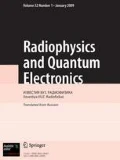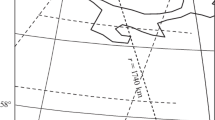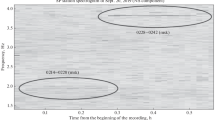Abstract
We present first results on generation and reception of an artificial ULF signal at distances of 800 and 1500 km in the frequency range 0.3–12 Hz. The high-sensitivity receiving equipment and a stable current in the antenna exciting the ULF field in the Earth-ionosphere cavity allowed us to detect the signal with high accuracy. It was found that the amplitude-frequency dependences and the polarization of an artificial signal are strongly different in the daytime and at night, which is related to the influence of the near-Earth waveguide and resonance structures on the detected signal. We calculate the signal amplitude for different models of the ionosphere. It is shown that the model of an anisotropic, vertically inhomogeneous ionosphere describes adequately the amplitude-frequency dependences of the measured ULF signal. We calculate the apparent resistance of the underlying surface at the reception point using two measured orthogonal components H_x and E_y of an electromagnetic field. It is shown that the calculation accuracy of the apparent resistance obtained using a controlled ULF source exceeds significantly the accuracy achieved using natural electromagnetic fields.
Similar content being viewed by others
REFERENCES
E. P. Velikhov, A. A. Zhamaletdinov, L. A. Sobchakov, et al., Dokl. Rossiisk. Akad. Nauk, 338, No. 1, 11 (1994).
A. K. Saraev, P. M. Kostkin, and V. G. Ivochkin, Fiz. Zemli, No. 7, 50 (1998).
P. P. Belyaev, S. V. Polyakov, E. N. Ermakova, and S. V. Isaev, Izv. Vysshikh Uchebn. Zaved., Radiofiz., 40, 1305 (1997).
A. B. Fedorov, A. A. Eliseev, A. B. Kocherov, K. D. Ratnikov, and G. V. Red'ko, Geofiz. Apparat., No. 101, 81 (1998).
P. R. Bannister, F. J. Williams, A. L. Dahlvig, and W. A. Kraimer, IEEE Trans. Commun., 22, No. 4, 412 (1974).
P. P. Belyaev, S. V. Polyakov, V. O. Rapoport, and V. Yu. Trakhtengerts, Izv. Vysshikh Uchebn. Zaved., Radiofiz., 32, 663 (1989).
P. P. Belyaev, S. V. Polyakov, V. O. Rapoport, and V. Yu. Trakhtengerts, Izv. Vysshikh Uchebn. Zaved., Radiofiz., 32, No. 7, 802 (1989).
D. D. Sentmann, Radio Sci., 22, No. 4, 595 (1987).
S. Fujita, J. Geophys. Res., 93, No. 12, 14674 (1988).
C. Greifinger and P. Greifinger, Radio Sci., 9, No. 5, 533 (1974).
P. P. Belyaev, S. V. Polyakov, V. O. Rapoport, and V. Y. Trakhtengerts, J. Atmos. Terr. Phys., 52, No. 9, 781 (1990).
S. V. Polyakov and V. O. Rapoport, Geomagn. Aéron., 21, No. 5, 610 (1981).
Author information
Authors and Affiliations
Rights and permissions
About this article
Cite this article
Belyaev, P.P., Ermakova, E.N., Isaev, S.V. et al. First Experiments on Generating and Receiving Artificial ULF (0.3–12 Hz) Emissions at a Distance of 1500 km. Radiophysics and Quantum Electronics 45, 135–146 (2002). https://doi.org/10.1023/A:1015949625839
Issue Date:
DOI: https://doi.org/10.1023/A:1015949625839




